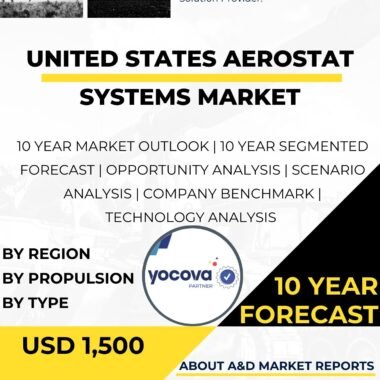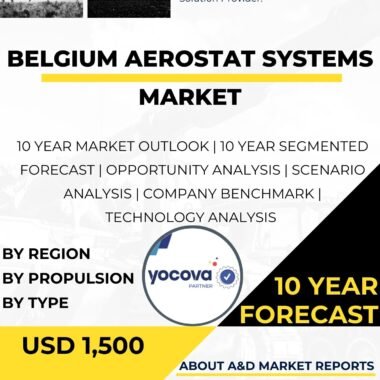Description
The Spain Maritime Surveillance Aircraft Market is a crucial and dynamic sector that plays a pivotal role in safeguarding Spain’s maritime borders and ensuring maritime security. Maritime surveillance aircraft are specialized aircraft equipped with advanced sensors, radar systems, and communication suites to conduct surveillance, reconnaissance, and patrol missions over maritime territories. These aircraft are vital for monitoring maritime activities, detecting illegal activities, and responding to potential threats in Spain’s territorial waters and exclusive economic zone.
The growth of the Spain Maritime Surveillance Aircraft Market can be attributed to several key factors. First and foremost, advancements in aerospace and sensor technologies have significantly improved the performance and capabilities of maritime surveillance aircraft. Modern aircraft are equipped with state-of-the-art sensors, radar, and communication systems, providing enhanced situational awareness and maritime domain awareness for the Spanish Navy and Coast Guard.
Moreover, the increasing importance of maritime security and the rise of maritime threats have heightened the demand for advanced maritime surveillance solutions. Spain’s extensive coastline, significant maritime trade, and growing energy exploration activities in its waters make maritime surveillance aircraft an essential asset for protecting national interests and responding to potential security challenges.
The Spanish Navy and Coast Guard recognize the strategic importance of investing in maritime surveillance aircraft to maintain a strong maritime security posture. These aircraft enable timely detection and response to illegal activities, such as drug trafficking, smuggling, and illegal fishing, contributing to the overall maritime security and safety of Spain’s territorial waters.
Furthermore, the Spain Maritime Surveillance Aircraft Market benefits from collaboration and joint development programs with other European nations. Spain’s involvement in joint maritime surveillance initiatives fosters technological exchange, cost-sharing, and interoperability between maritime surveillance forces, promoting a stronger and more capable European maritime security ecosystem.
In addition to their surveillance capabilities, maritime surveillance aircraft also have critical applications in search and rescue operations. These aircraft can cover vast areas of the ocean and quickly locate distressed vessels or individuals, contributing to the effectiveness and efficiency of search and rescue efforts.
The versatility of maritime surveillance aircraft is another significant driver of market growth. These aircraft can be adapted to various mission scenarios, including anti-submarine warfare, anti-surface warfare, maritime patrol, and search and rescue missions. Their ability to operate over long distances and remain airborne for extended periods allows for extended surveillance and rapid response to potential maritime threats.
However, the growth of the Spain Maritime Surveillance Aircraft Market also presents challenges. One of the primary concerns is the need for continual investment in research and development to keep pace with advancements in aerospace and sensor technologies. As maritime threats evolve, continuous innovation is essential to ensure that maritime surveillance aircraft remain at the forefront of maritime security and surveillance capabilities.
Moreover, ensuring the interoperability and integration of maritime surveillance aircraft with other military platforms and systems is essential. Different aircraft and maritime assets may use different communication protocols and standards, requiring careful integration and coordination to ensure seamless data exchange and maritime domain awareness.
Another challenge lies in addressing the issue of training and readiness of operators and personnel responsible for operating maritime surveillance aircraft. The complexity of the systems and the critical nature of maritime surveillance missions require skilled and well-trained personnel to ensure the effectiveness and safety of the aircraft in maritime operations.
Furthermore, the Spain Maritime Surveillance Aircraft Market must address sustainability and life cycle support concerns. Maintaining and servicing a fleet of maritime surveillance aircraft over their operational life span requires ongoing investment in logistics, maintenance, and spare parts to ensure the aircraft’s continued operational readiness.
In conclusion, the Spain Maritime Surveillance Aircraft Market is a critical enabler of maritime security, providing advanced aerial surveillance capabilities for monitoring Spain’s territorial waters and exclusive economic zone. The market’s growth is driven by advancements in aerospace and sensor technologies, the increasing importance of maritime security, and collaboration in joint maritime surveillance initiatives with other European nations. Maritime surveillance aircraft contribute to the overall maritime security and safety of Spain’s maritime territories, enabling timely detection and response to potential maritime threats. However, challenges related to technological advancement, interoperability, training, and sustainability must be addressed to ensure the continuous effectiveness and resilience of maritime surveillance aircraft in safeguarding national maritime security and defense objectives. As technology continues to evolve, maritime surveillance aircraft will remain a critical aspect of modern maritime security strategies, shaping the future of maritime domain awareness and surveillance capabilities.




